Application of Green's Theorem in Vector Field Analysis
VerifiedAdded on 2023/04/03
|13
|2259
|148
Homework Assignment
AI Summary
This assignment presents a detailed analysis of Green's Theorem, a fundamental concept in vector calculus. The solution explores the application of Green's Theorem to evaluate line integrals and double integrals, demonstrating the relationship between them. The assignment covers the calculation of circulation for given vector fields, verification of Green's Theorem through line and double integral evaluations, and the determination of areas enclosed by curves. Furthermore, it delves into the curl of vector fields, expressing velocity in both Cartesian and cylindrical coordinates, and the transformation between them. The assignment also investigates the behavior of vector fields as a parameter (n) changes, providing a comprehensive understanding of Green's Theorem and its applications in vector field analysis.
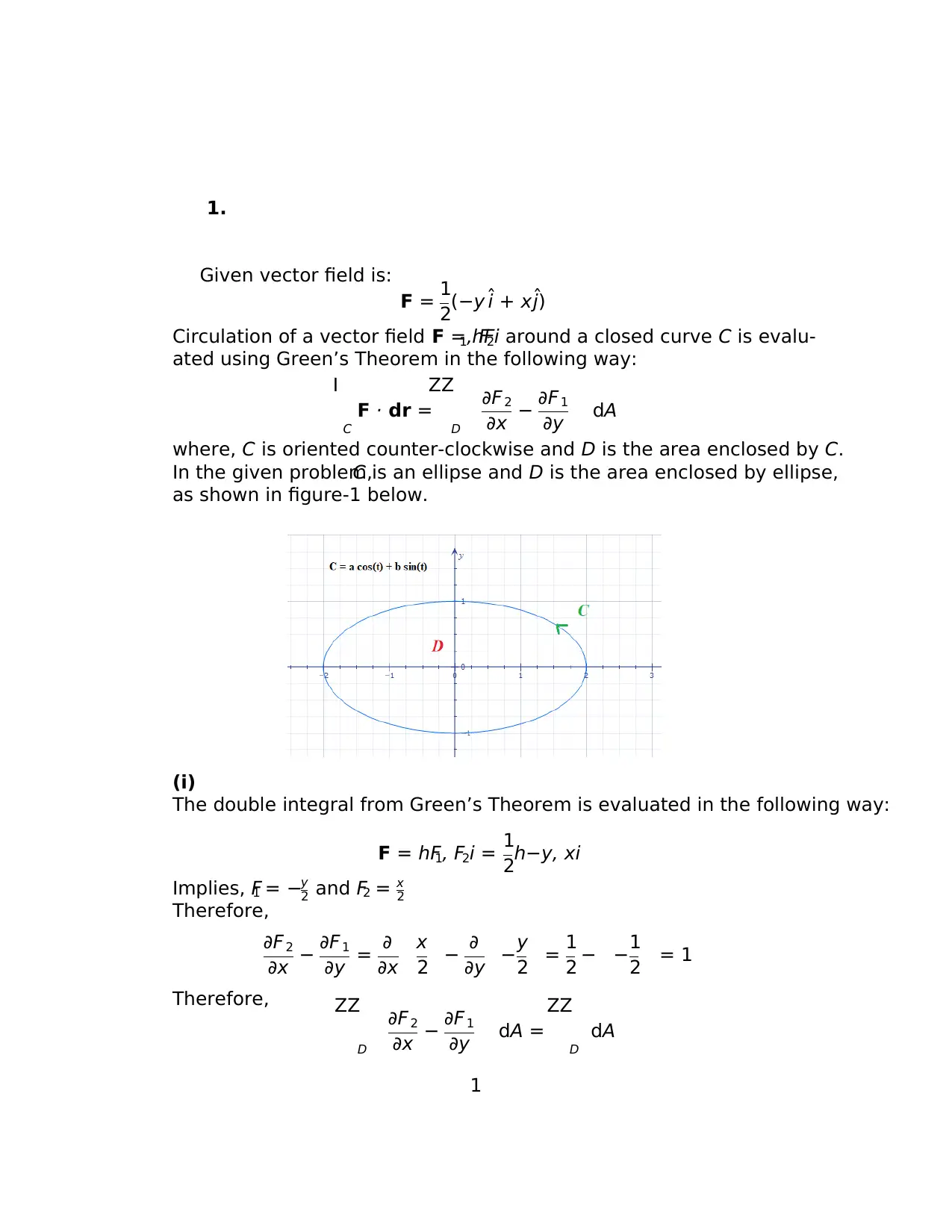
1.
Given vector field is:
F = 1
2(−yˆi + xˆj)
Circulation of a vector field F = hF1, F2i around a closed curve C is evalu-
ated using Green’s Theorem in the following way:
I
C
F · dr =
ZZ
D
∂F 2
∂x − ∂F 1
∂y dA
where, C is oriented counter-clockwise and D is the area enclosed by C.
In the given problem,C is an ellipse and D is the area enclosed by ellipse,
as shown in figure-1 below.
(i)
The double integral from Green’s Theorem is evaluated in the following way:
F = hF1, F2i = 1
2h−y, xi
Implies, F1 = −y
2 and F2 = x
2
Therefore,
∂F 2
∂x − ∂F 1
∂y = ∂
∂x
x
2 − ∂
∂y −y
2 = 1
2 − −1
2 = 1
Therefore, ZZ
D
∂F2
∂x − ∂F 1
∂y dA =
ZZ
D
dA
1
Given vector field is:
F = 1
2(−yˆi + xˆj)
Circulation of a vector field F = hF1, F2i around a closed curve C is evalu-
ated using Green’s Theorem in the following way:
I
C
F · dr =
ZZ
D
∂F 2
∂x − ∂F 1
∂y dA
where, C is oriented counter-clockwise and D is the area enclosed by C.
In the given problem,C is an ellipse and D is the area enclosed by ellipse,
as shown in figure-1 below.
(i)
The double integral from Green’s Theorem is evaluated in the following way:
F = hF1, F2i = 1
2h−y, xi
Implies, F1 = −y
2 and F2 = x
2
Therefore,
∂F 2
∂x − ∂F 1
∂y = ∂
∂x
x
2 − ∂
∂y −y
2 = 1
2 − −1
2 = 1
Therefore, ZZ
D
∂F2
∂x − ∂F 1
∂y dA =
ZZ
D
dA
1
Paraphrase This Document
Need a fresh take? Get an instant paraphrase of this document with our AI Paraphraser
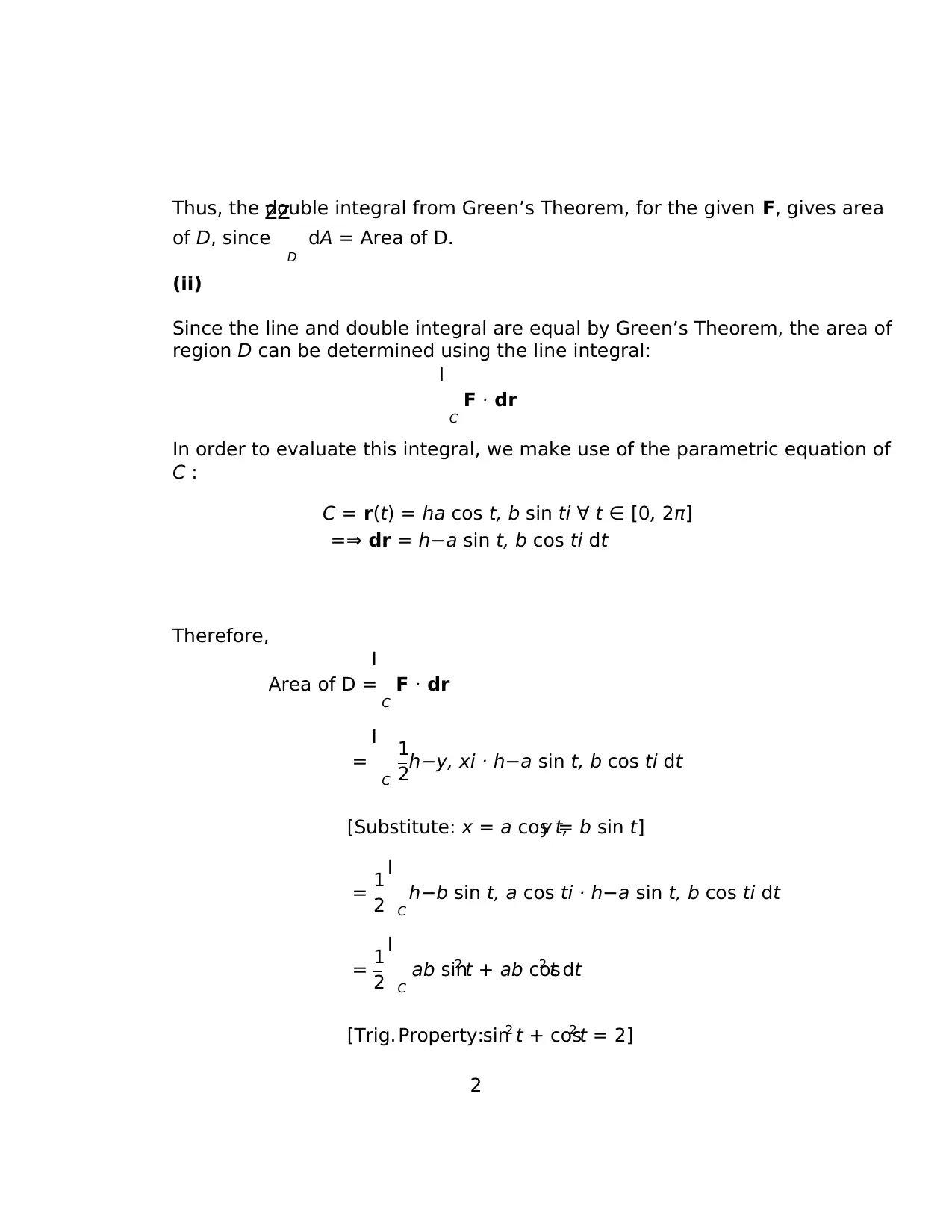
Thus, the double integral from Green’s Theorem, for the given F, gives area
of D, since
ZZ
D
dA = Area of D.
(ii)
Since the line and double integral are equal by Green’s Theorem, the area of
region D can be determined using the line integral:
I
C
F · dr
In order to evaluate this integral, we make use of the parametric equation of
C :
C = r(t) = ha cos t, b sin ti ∀ t ∈ [0, 2π]
=⇒ dr = h−a sin t, b cos ti dt
Therefore,
Area of D =
I
C
F · dr
=
I
C
1
2h−y, xi · h−a sin t, b cos ti dt
[Substitute: x = a cos t,y = b sin t]
= 1
2
I
C
h−b sin t, a cos ti · h−a sin t, b cos ti dt
= 1
2
I
C
ab sin2 t + ab cos2 t dt
[Trig. Property:sin2 t + cos2 t = 2]
2
of D, since
ZZ
D
dA = Area of D.
(ii)
Since the line and double integral are equal by Green’s Theorem, the area of
region D can be determined using the line integral:
I
C
F · dr
In order to evaluate this integral, we make use of the parametric equation of
C :
C = r(t) = ha cos t, b sin ti ∀ t ∈ [0, 2π]
=⇒ dr = h−a sin t, b cos ti dt
Therefore,
Area of D =
I
C
F · dr
=
I
C
1
2h−y, xi · h−a sin t, b cos ti dt
[Substitute: x = a cos t,y = b sin t]
= 1
2
I
C
h−b sin t, a cos ti · h−a sin t, b cos ti dt
= 1
2
I
C
ab sin2 t + ab cos2 t dt
[Trig. Property:sin2 t + cos2 t = 2]
2
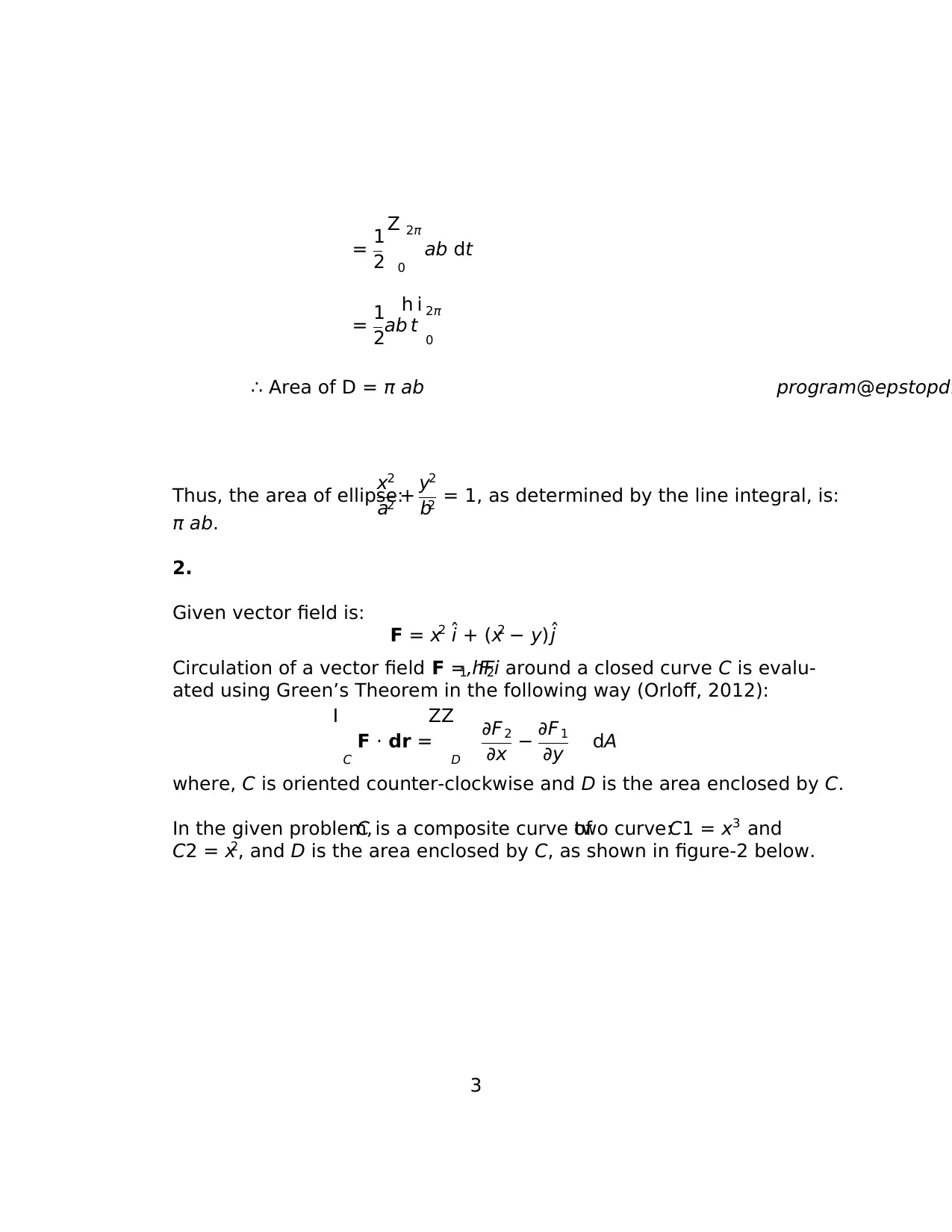
= 1
2
Z 2π
0
ab dt
= 1
2ab
h
t
i 2π
0
∴ Area of D = π ab program@epstopdf
Thus, the area of ellipse:
x2
a2 + y2
b2 = 1, as determined by the line integral, is:
π ab.
2.
Given vector field is:
F = x2 ˆi + (x2 − y)ˆj
Circulation of a vector field F = hF1, F2i around a closed curve C is evalu-
ated using Green’s Theorem in the following way (Orloff, 2012):
I
C
F · dr =
ZZ
D
∂F 2
∂x − ∂F 1
∂y dA
where, C is oriented counter-clockwise and D is the area enclosed by C.
In the given problem,C is a composite curve oftwo curve:C1 = x3 and
C2 = x2, and D is the area enclosed by C, as shown in figure-2 below.
3
2
Z 2π
0
ab dt
= 1
2ab
h
t
i 2π
0
∴ Area of D = π ab program@epstopdf
Thus, the area of ellipse:
x2
a2 + y2
b2 = 1, as determined by the line integral, is:
π ab.
2.
Given vector field is:
F = x2 ˆi + (x2 − y)ˆj
Circulation of a vector field F = hF1, F2i around a closed curve C is evalu-
ated using Green’s Theorem in the following way (Orloff, 2012):
I
C
F · dr =
ZZ
D
∂F 2
∂x − ∂F 1
∂y dA
where, C is oriented counter-clockwise and D is the area enclosed by C.
In the given problem,C is a composite curve oftwo curve:C1 = x3 and
C2 = x2, and D is the area enclosed by C, as shown in figure-2 below.
3
⊘ This is a preview!⊘
Do you want full access?
Subscribe today to unlock all pages.

Trusted by 1+ million students worldwide
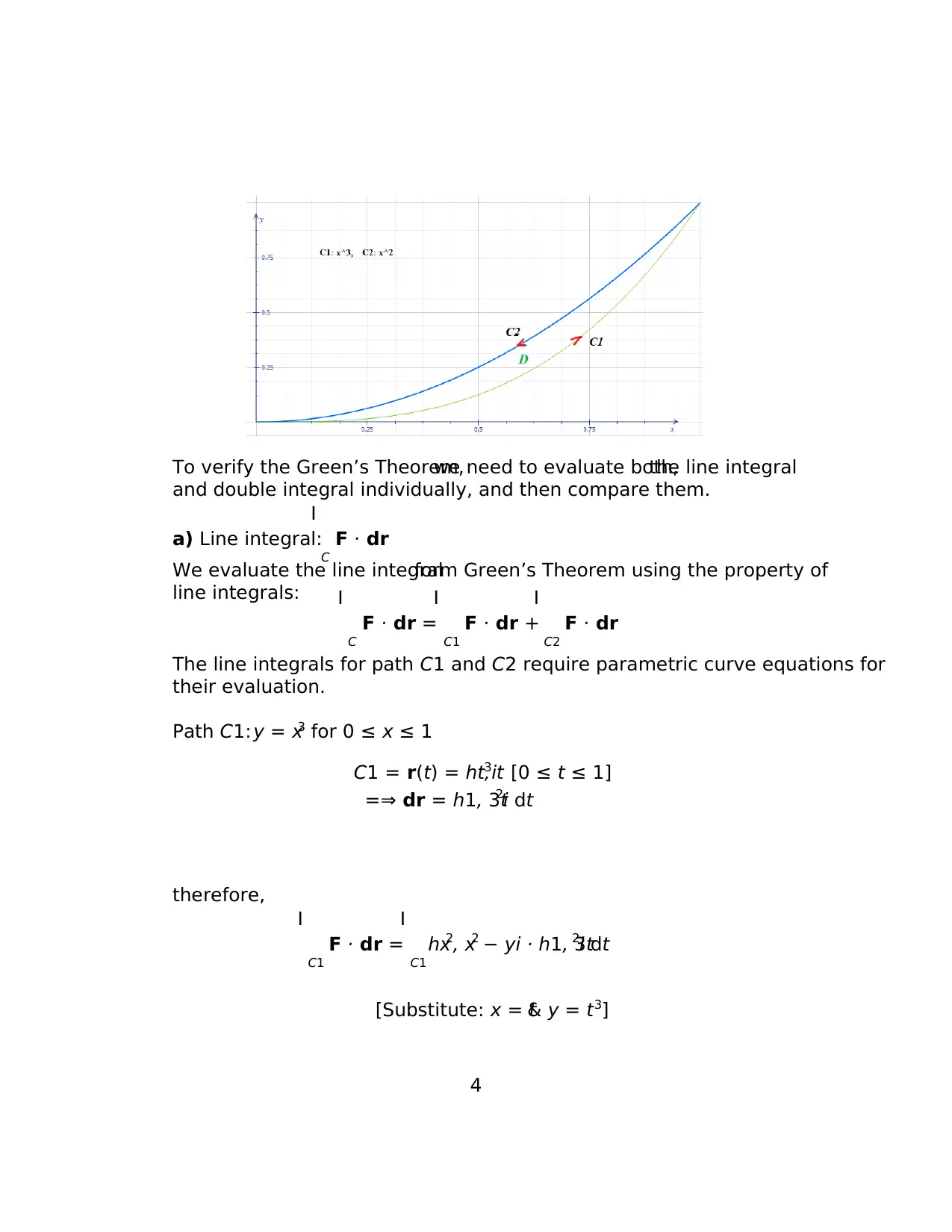
To verify the Green’s Theorem,we need to evaluate both,the line integral
and double integral individually, and then compare them.
a) Line integral:
I
C
F · dr
We evaluate the line integralform Green’s Theorem using the property of
line integrals: I
C
F · dr =
I
C1
F · dr +
I
C2
F · dr
The line integrals for path C1 and C2 require parametric curve equations for
their evaluation.
Path C1: y = x3 for 0 ≤ x ≤ 1
C1 = r(t) = ht, t3i [0 ≤ t ≤ 1]
=⇒ dr = h1, 3t2i dt
therefore,
I
C1
F · dr =
I
C1
hx2, x2 − yi · h1, 3t2i dt
[Substitute: x = t& y = t3]
4
and double integral individually, and then compare them.
a) Line integral:
I
C
F · dr
We evaluate the line integralform Green’s Theorem using the property of
line integrals: I
C
F · dr =
I
C1
F · dr +
I
C2
F · dr
The line integrals for path C1 and C2 require parametric curve equations for
their evaluation.
Path C1: y = x3 for 0 ≤ x ≤ 1
C1 = r(t) = ht, t3i [0 ≤ t ≤ 1]
=⇒ dr = h1, 3t2i dt
therefore,
I
C1
F · dr =
I
C1
hx2, x2 − yi · h1, 3t2i dt
[Substitute: x = t& y = t3]
4
Paraphrase This Document
Need a fresh take? Get an instant paraphrase of this document with our AI Paraphraser
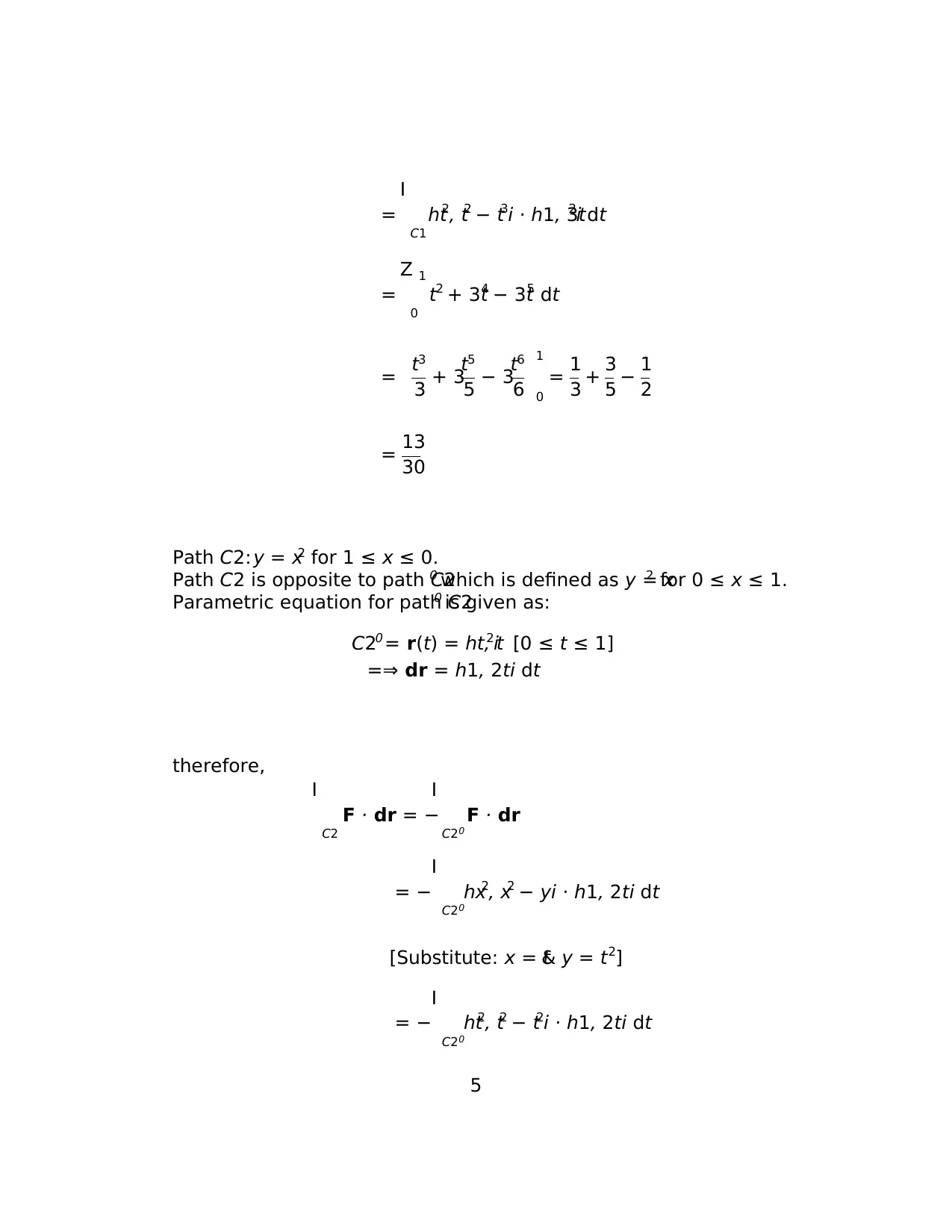
=
I
C1
ht2, t2 − t3i · h1, 3t2i dt
=
Z 1
0
t2 + 3t4 − 3t5 dt
= t3
3 + 3
t5
5 − 3
t6
6
1
0
= 1
3 + 3
5 − 1
2
= 13
30
Path C2: y = x2 for 1 ≤ x ≤ 0.
Path C2 is opposite to path C20 which is defined as y = x2 for 0 ≤ x ≤ 1.
Parametric equation for path C20 is given as:
C20 = r(t) = ht, t2i [0 ≤ t ≤ 1]
=⇒ dr = h1, 2ti dt
therefore,
I
C2
F · dr = −
I
C20
F · dr
= −
I
C20
hx2, x2 − yi · h1, 2ti dt
[Substitute: x = t& y = t2]
= −
I
C20
ht2, t2 − t2i · h1, 2ti dt
5
I
C1
ht2, t2 − t3i · h1, 3t2i dt
=
Z 1
0
t2 + 3t4 − 3t5 dt
= t3
3 + 3
t5
5 − 3
t6
6
1
0
= 1
3 + 3
5 − 1
2
= 13
30
Path C2: y = x2 for 1 ≤ x ≤ 0.
Path C2 is opposite to path C20 which is defined as y = x2 for 0 ≤ x ≤ 1.
Parametric equation for path C20 is given as:
C20 = r(t) = ht, t2i [0 ≤ t ≤ 1]
=⇒ dr = h1, 2ti dt
therefore,
I
C2
F · dr = −
I
C20
F · dr
= −
I
C20
hx2, x2 − yi · h1, 2ti dt
[Substitute: x = t& y = t2]
= −
I
C20
ht2, t2 − t2i · h1, 2ti dt
5
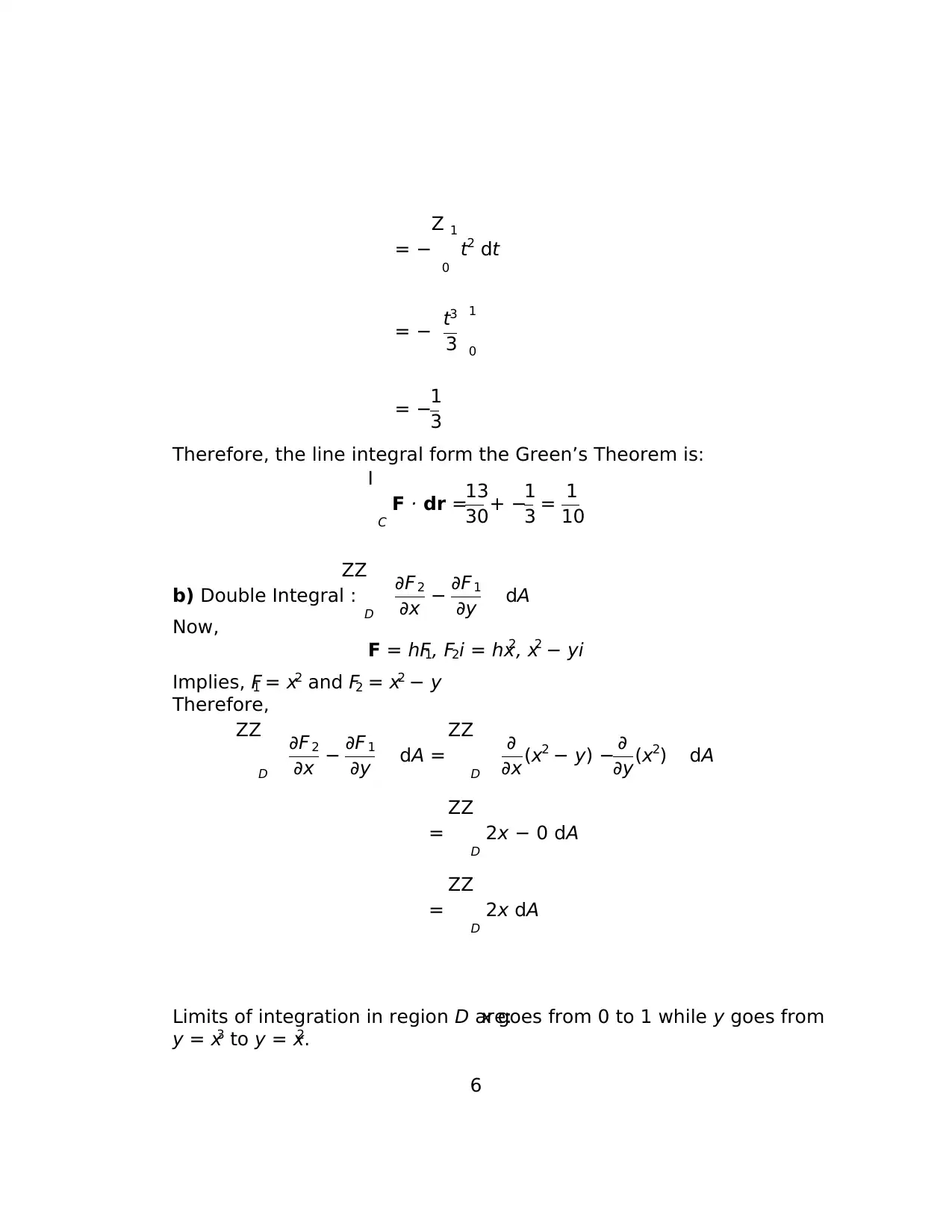
= −
Z 1
0
t2 dt
= − t3
3
1
0
= −1
3
Therefore, the line integral form the Green’s Theorem is:
I
C
F · dr =13
30+ −1
3 = 1
10
b) Double Integral :
ZZ
D
∂F2
∂x − ∂F 1
∂y dA
Now,
F = hF1, F2i = hx2, x2 − yi
Implies, F1 = x2 and F2 = x2 − y
Therefore,
ZZ
D
∂F 2
∂x − ∂F 1
∂y dA =
ZZ
D
∂
∂x (x2 − y) − ∂
∂y(x2) dA
=
ZZ
D
2x − 0 dA
=
ZZ
D
2x dA
Limits of integration in region D are:x goes from 0 to 1 while y goes from
y = x3 to y = x2.
6
Z 1
0
t2 dt
= − t3
3
1
0
= −1
3
Therefore, the line integral form the Green’s Theorem is:
I
C
F · dr =13
30+ −1
3 = 1
10
b) Double Integral :
ZZ
D
∂F2
∂x − ∂F 1
∂y dA
Now,
F = hF1, F2i = hx2, x2 − yi
Implies, F1 = x2 and F2 = x2 − y
Therefore,
ZZ
D
∂F 2
∂x − ∂F 1
∂y dA =
ZZ
D
∂
∂x (x2 − y) − ∂
∂y(x2) dA
=
ZZ
D
2x − 0 dA
=
ZZ
D
2x dA
Limits of integration in region D are:x goes from 0 to 1 while y goes from
y = x3 to y = x2.
6
⊘ This is a preview!⊘
Do you want full access?
Subscribe today to unlock all pages.

Trusted by 1+ million students worldwide
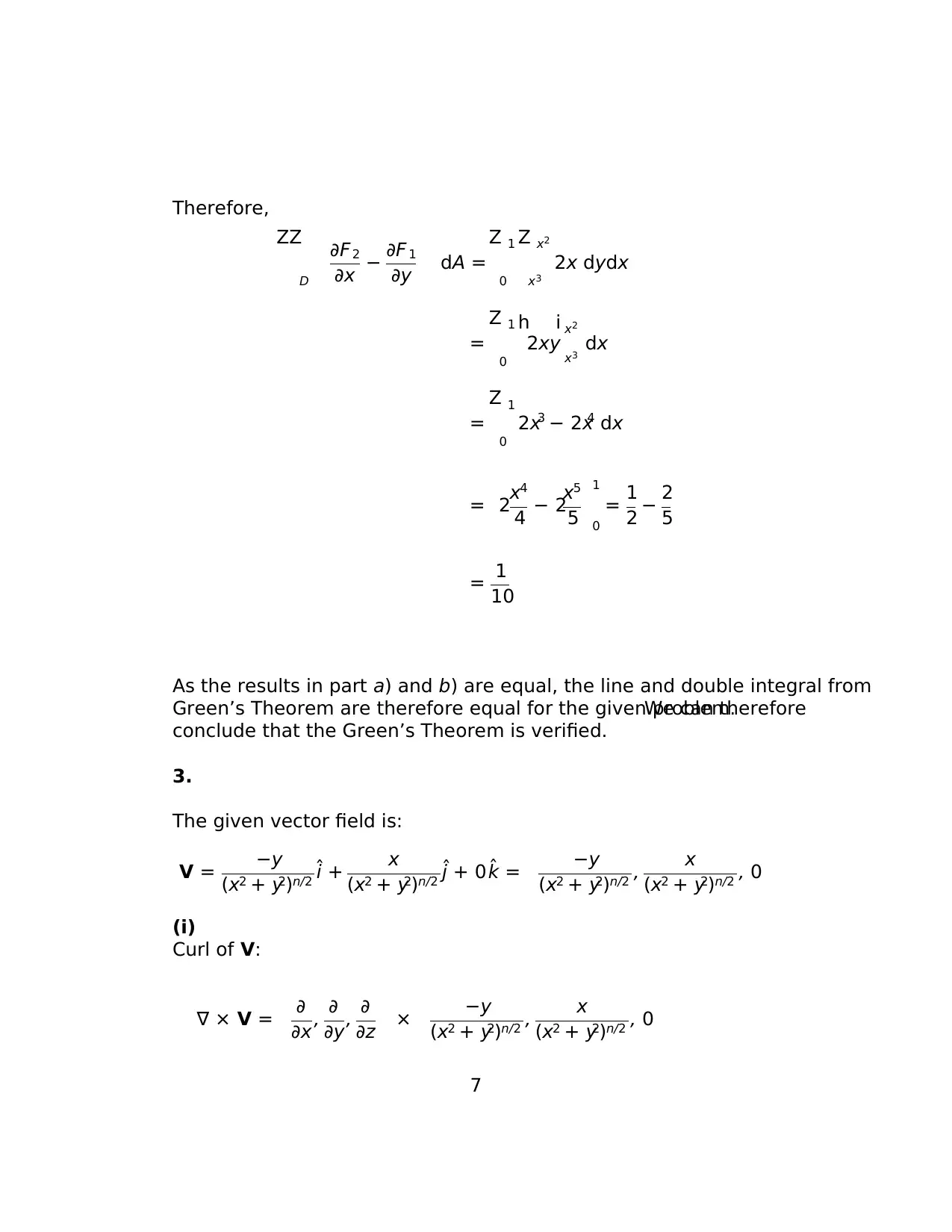
Therefore,
ZZ
D
∂F2
∂x − ∂F 1
∂y dA =
Z 1
0
Z x2
x3
2x dydx
=
Z 1
0
h
2xy
i x2
x3 dx
=
Z 1
0
2x3 − 2x4 dx
= 2x4
4 − 2
x5
5
1
0
= 1
2 − 2
5
= 1
10
As the results in part a) and b) are equal, the line and double integral from
Green’s Theorem are therefore equal for the given problem.We can therefore
conclude that the Green’s Theorem is verified.
3.
The given vector field is:
V = −y
(x2 + y2)n/2 ˆi + x
(x2 + y2)n/2 ˆj + 0 ˆk = −y
(x2 + y2)n/2 , x
(x2 + y2)n/2 , 0
(i)
Curl of V:
∇ × V = ∂
∂x , ∂
∂y, ∂
∂z × −y
(x2 + y2)n/2 , x
(x2 + y2)n/2 , 0
7
ZZ
D
∂F2
∂x − ∂F 1
∂y dA =
Z 1
0
Z x2
x3
2x dydx
=
Z 1
0
h
2xy
i x2
x3 dx
=
Z 1
0
2x3 − 2x4 dx
= 2x4
4 − 2
x5
5
1
0
= 1
2 − 2
5
= 1
10
As the results in part a) and b) are equal, the line and double integral from
Green’s Theorem are therefore equal for the given problem.We can therefore
conclude that the Green’s Theorem is verified.
3.
The given vector field is:
V = −y
(x2 + y2)n/2 ˆi + x
(x2 + y2)n/2 ˆj + 0 ˆk = −y
(x2 + y2)n/2 , x
(x2 + y2)n/2 , 0
(i)
Curl of V:
∇ × V = ∂
∂x , ∂
∂y, ∂
∂z × −y
(x2 + y2)n/2 , x
(x2 + y2)n/2 , 0
7
Paraphrase This Document
Need a fresh take? Get an instant paraphrase of this document with our AI Paraphraser
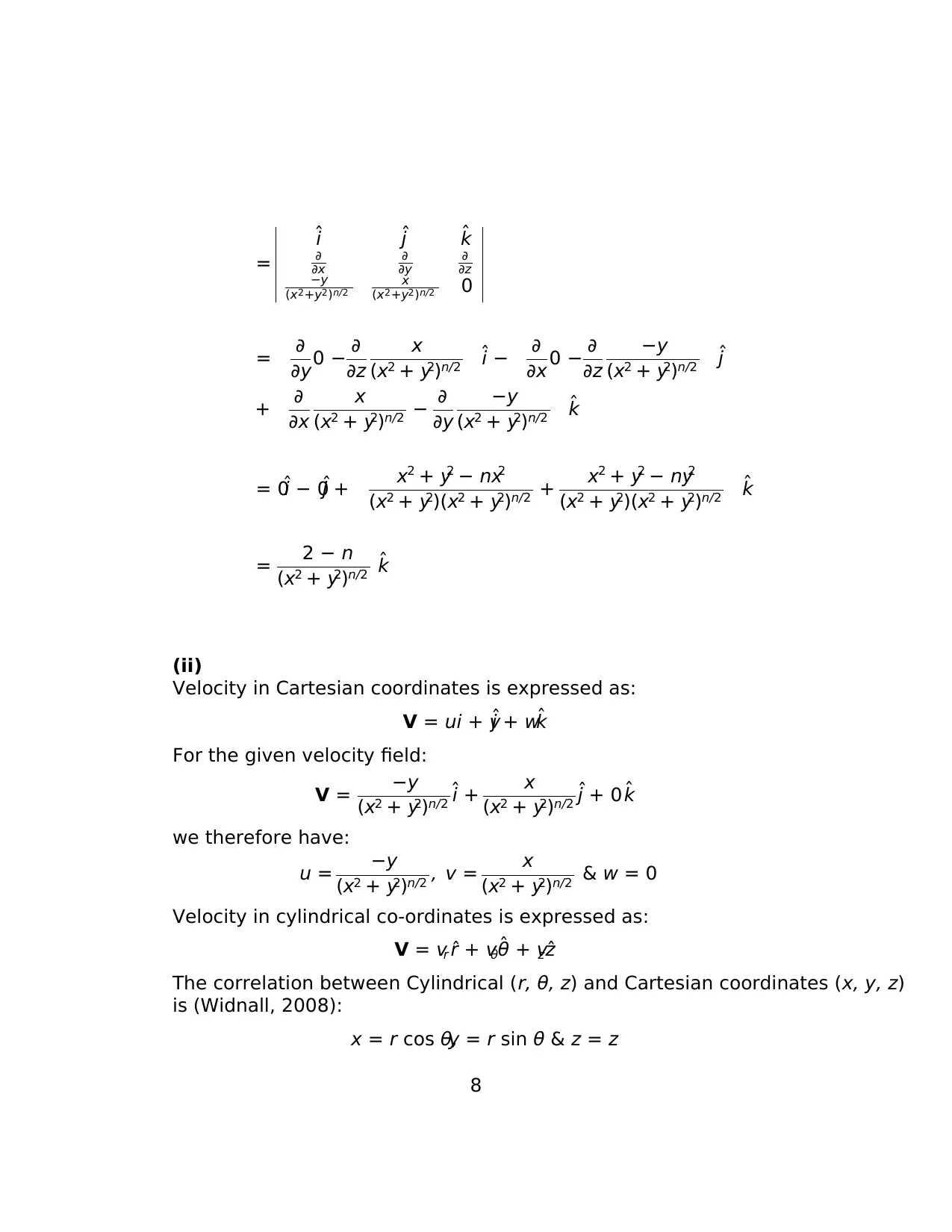
=
ˆi ˆj ˆk
∂
∂x
∂
∂y
∂
∂z
−y
(x2+y2)n/2
x
(x2+y2)n/2 0
= ∂
∂y0 − ∂
∂z
x
(x2 + y2)n/2 ˆi − ∂
∂x 0 − ∂
∂z
−y
(x2 + y2)n/2 ˆj
+ ∂
∂x
x
(x2 + y2)n/2 − ∂
∂y
−y
(x2 + y2)n/2 ˆk
= 0ˆi − 0ˆj + x2 + y2 − nx2
(x2 + y2)(x2 + y2)n/2 + x2 + y2 − ny2
(x2 + y2)(x2 + y2)n/2 ˆk
= 2 − n
(x2 + y2)n/2 ˆk
(ii)
Velocity in Cartesian coordinates is expressed as:
V = ui + vˆj + wˆk
For the given velocity field:
V = −y
(x2 + y2)n/2 ˆi + x
(x2 + y2)n/2 ˆj + 0 ˆk
we therefore have:
u = −y
(x2 + y2)n/2 , v = x
(x2 + y2)n/2 & w = 0
Velocity in cylindrical co-ordinates is expressed as:
V = vr ˆr + vθˆθ + vz ˆz
The correlation between Cylindrical (r, θ, z) and Cartesian coordinates (x, y, z)
is (Widnall, 2008):
x = r cos θ,y = r sin θ & z = z
8
ˆi ˆj ˆk
∂
∂x
∂
∂y
∂
∂z
−y
(x2+y2)n/2
x
(x2+y2)n/2 0
= ∂
∂y0 − ∂
∂z
x
(x2 + y2)n/2 ˆi − ∂
∂x 0 − ∂
∂z
−y
(x2 + y2)n/2 ˆj
+ ∂
∂x
x
(x2 + y2)n/2 − ∂
∂y
−y
(x2 + y2)n/2 ˆk
= 0ˆi − 0ˆj + x2 + y2 − nx2
(x2 + y2)(x2 + y2)n/2 + x2 + y2 − ny2
(x2 + y2)(x2 + y2)n/2 ˆk
= 2 − n
(x2 + y2)n/2 ˆk
(ii)
Velocity in Cartesian coordinates is expressed as:
V = ui + vˆj + wˆk
For the given velocity field:
V = −y
(x2 + y2)n/2 ˆi + x
(x2 + y2)n/2 ˆj + 0 ˆk
we therefore have:
u = −y
(x2 + y2)n/2 , v = x
(x2 + y2)n/2 & w = 0
Velocity in cylindrical co-ordinates is expressed as:
V = vr ˆr + vθˆθ + vz ˆz
The correlation between Cylindrical (r, θ, z) and Cartesian coordinates (x, y, z)
is (Widnall, 2008):
x = r cos θ,y = r sin θ & z = z
8
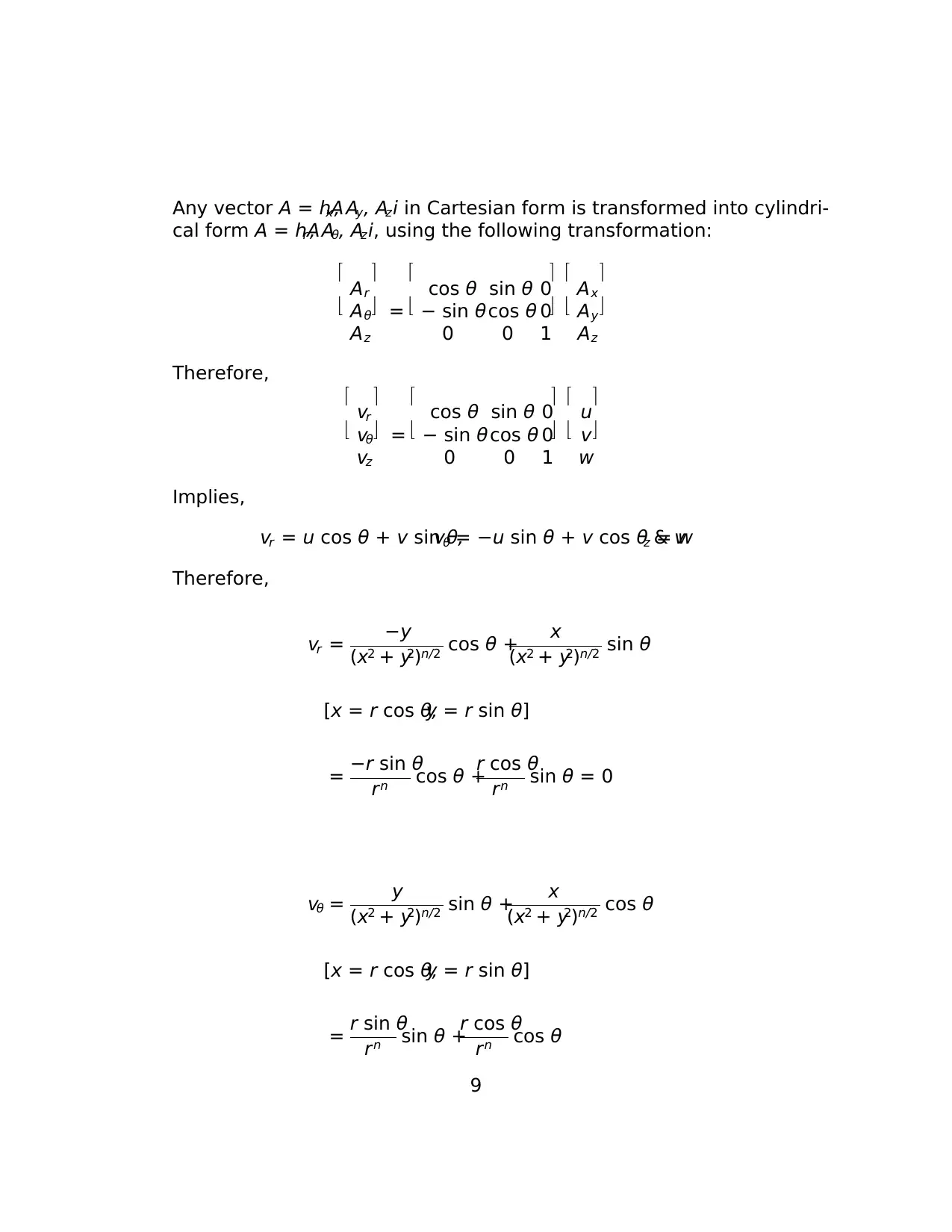
Any vector A = hAx, Ay, Azi in Cartesian form is transformed into cylindri-
cal form A = hAr , Aθ, Azi, using the following transformation:
Ar
Aθ
Az
=
cos θ sin θ 0
− sin θcos θ 0
0 0 1
Ax
Ay
Az
Therefore,
vr
vθ
vz
=
cos θ sin θ 0
− sin θcos θ 0
0 0 1
u
v
w
Implies,
vr = u cos θ + v sin θ,vθ = −u sin θ + v cos θ & vz = w
Therefore,
vr = −y
(x2 + y2)n/2 cos θ + x
(x2 + y2)n/2 sin θ
[x = r cos θ,y = r sin θ]
= −r sin θ
rn cos θ +
r cos θ
rn sin θ = 0
vθ = y
(x2 + y2)n/2 sin θ + x
(x2 + y2)n/2 cos θ
[x = r cos θ,y = r sin θ]
= r sin θ
rn sin θ +
r cos θ
rn cos θ
9
cal form A = hAr , Aθ, Azi, using the following transformation:
Ar
Aθ
Az
=
cos θ sin θ 0
− sin θcos θ 0
0 0 1
Ax
Ay
Az
Therefore,
vr
vθ
vz
=
cos θ sin θ 0
− sin θcos θ 0
0 0 1
u
v
w
Implies,
vr = u cos θ + v sin θ,vθ = −u sin θ + v cos θ & vz = w
Therefore,
vr = −y
(x2 + y2)n/2 cos θ + x
(x2 + y2)n/2 sin θ
[x = r cos θ,y = r sin θ]
= −r sin θ
rn cos θ +
r cos θ
rn sin θ = 0
vθ = y
(x2 + y2)n/2 sin θ + x
(x2 + y2)n/2 cos θ
[x = r cos θ,y = r sin θ]
= r sin θ
rn sin θ +
r cos θ
rn cos θ
9
⊘ This is a preview!⊘
Do you want full access?
Subscribe today to unlock all pages.

Trusted by 1+ million students worldwide
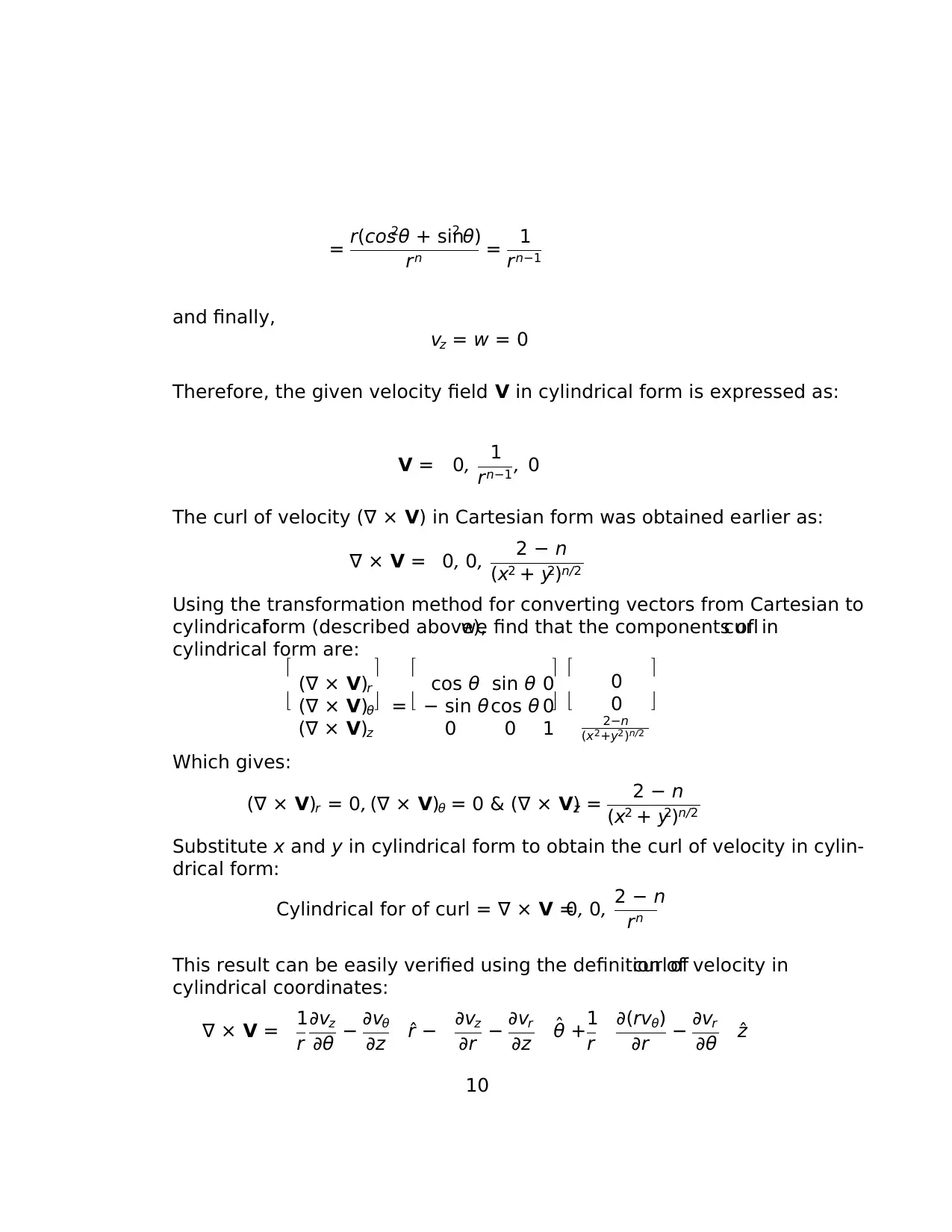
= r(cos2θ + sin2 θ)
rn = 1
rn−1
and finally,
vz = w = 0
Therefore, the given velocity field V in cylindrical form is expressed as:
V = 0, 1
rn−1 , 0
The curl of velocity (∇ × V) in Cartesian form was obtained earlier as:
∇ × V = 0, 0, 2 − n
(x2 + y2)n/2
Using the transformation method for converting vectors from Cartesian to
cylindricalform (described above),we find that the components ofcurl in
cylindrical form are:
(∇ × V)r
(∇ × V)θ
(∇ × V)z
=
cos θ sin θ 0
− sin θcos θ 0
0 0 1
0
0
2−n
(x2+y2)n/2
Which gives:
(∇ × V)r = 0, (∇ × V)θ = 0 & (∇ × V)z = 2 − n
(x2 + y2)n/2
Substitute x and y in cylindrical form to obtain the curl of velocity in cylin-
drical form:
Cylindrical for of curl = ∇ × V =0, 0, 2 − n
rn
This result can be easily verified using the definition ofcurl of velocity in
cylindrical coordinates:
∇ × V = 1
r
∂vz
∂θ − ∂vθ
∂z ˆr − ∂vz
∂r − ∂vr
∂z ˆθ +1
r
∂(rvθ)
∂r − ∂vr
∂θ ˆz
10
rn = 1
rn−1
and finally,
vz = w = 0
Therefore, the given velocity field V in cylindrical form is expressed as:
V = 0, 1
rn−1 , 0
The curl of velocity (∇ × V) in Cartesian form was obtained earlier as:
∇ × V = 0, 0, 2 − n
(x2 + y2)n/2
Using the transformation method for converting vectors from Cartesian to
cylindricalform (described above),we find that the components ofcurl in
cylindrical form are:
(∇ × V)r
(∇ × V)θ
(∇ × V)z
=
cos θ sin θ 0
− sin θcos θ 0
0 0 1
0
0
2−n
(x2+y2)n/2
Which gives:
(∇ × V)r = 0, (∇ × V)θ = 0 & (∇ × V)z = 2 − n
(x2 + y2)n/2
Substitute x and y in cylindrical form to obtain the curl of velocity in cylin-
drical form:
Cylindrical for of curl = ∇ × V =0, 0, 2 − n
rn
This result can be easily verified using the definition ofcurl of velocity in
cylindrical coordinates:
∇ × V = 1
r
∂vz
∂θ − ∂vθ
∂z ˆr − ∂vz
∂r − ∂vr
∂z ˆθ +1
r
∂(rvθ)
∂r − ∂vr
∂θ ˆz
10
Paraphrase This Document
Need a fresh take? Get an instant paraphrase of this document with our AI Paraphraser
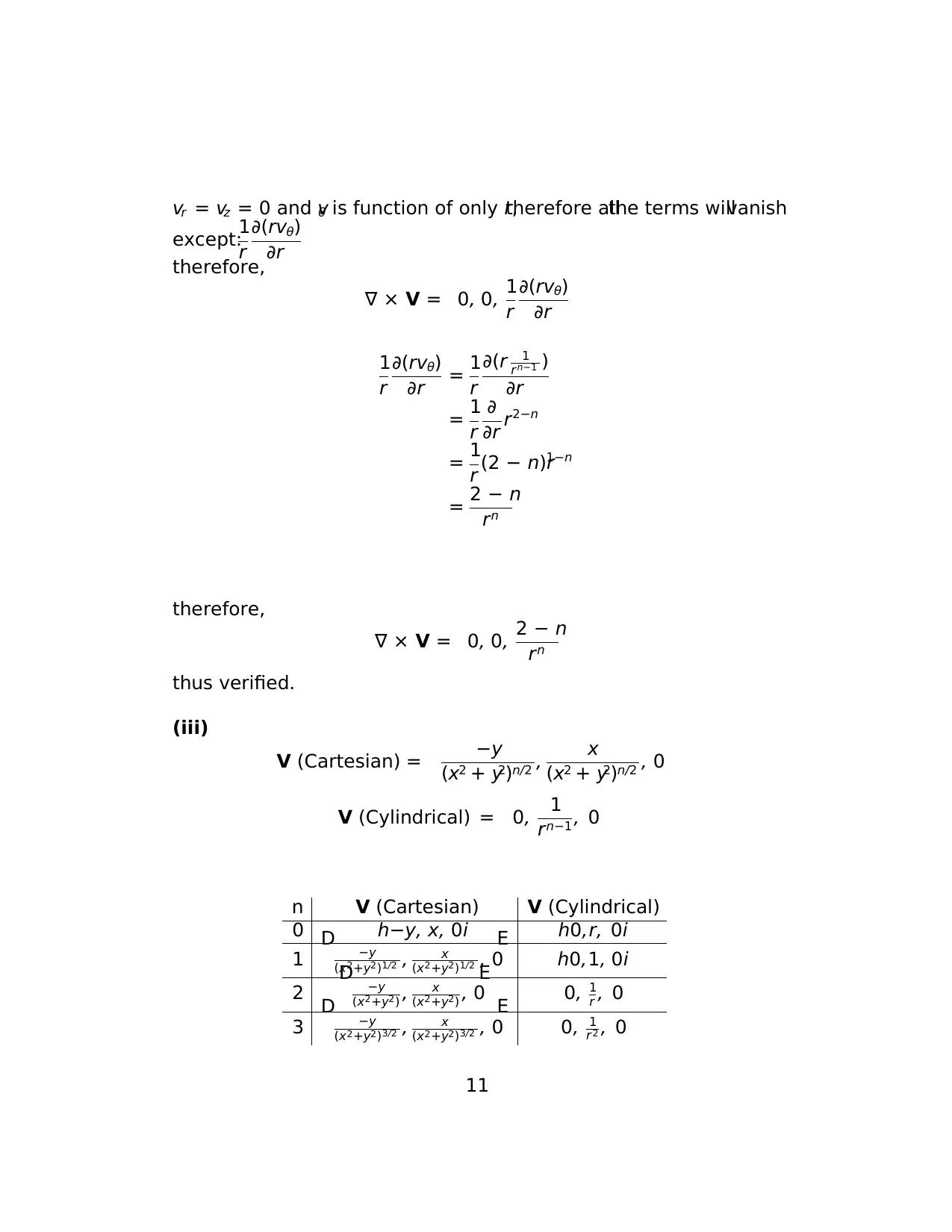
vr = vz = 0 and vθ is function of only r,therefore allthe terms willvanish
except:1
r
∂(rvθ)
∂r
therefore,
∇ × V = 0, 0, 1
r
∂(rvθ)
∂r
1
r
∂(rvθ)
∂r = 1
r
∂(r 1
rn−1 )
∂r
= 1
r
∂
∂r r2−n
= 1
r (2 − n)r1−n
= 2 − n
rn
therefore,
∇ × V = 0, 0, 2 − n
rn
thus verified.
(iii)
V (Cartesian) = −y
(x2 + y2)n/2 , x
(x2 + y2)n/2 , 0
V (Cylindrical) = 0, 1
rn−1 , 0
n V (Cartesian) V (Cylindrical)
0 h−y, x, 0i h0,r, 0i
1
D −y
(x2+y2)1/2 , x
(x2+y2)1/2 , 0
E
h0,1, 0i
2
D −y
(x2+y2) , x
(x2+y2) , 0
E
0, 1
r , 0
3
D −y
(x2+y2)3/2 , x
(x2+y2)3/2 , 0
E
0, 1
r 2 , 0
11
except:1
r
∂(rvθ)
∂r
therefore,
∇ × V = 0, 0, 1
r
∂(rvθ)
∂r
1
r
∂(rvθ)
∂r = 1
r
∂(r 1
rn−1 )
∂r
= 1
r
∂
∂r r2−n
= 1
r (2 − n)r1−n
= 2 − n
rn
therefore,
∇ × V = 0, 0, 2 − n
rn
thus verified.
(iii)
V (Cartesian) = −y
(x2 + y2)n/2 , x
(x2 + y2)n/2 , 0
V (Cylindrical) = 0, 1
rn−1 , 0
n V (Cartesian) V (Cylindrical)
0 h−y, x, 0i h0,r, 0i
1
D −y
(x2+y2)1/2 , x
(x2+y2)1/2 , 0
E
h0,1, 0i
2
D −y
(x2+y2) , x
(x2+y2) , 0
E
0, 1
r , 0
3
D −y
(x2+y2)3/2 , x
(x2+y2)3/2 , 0
E
0, 1
r 2 , 0
11
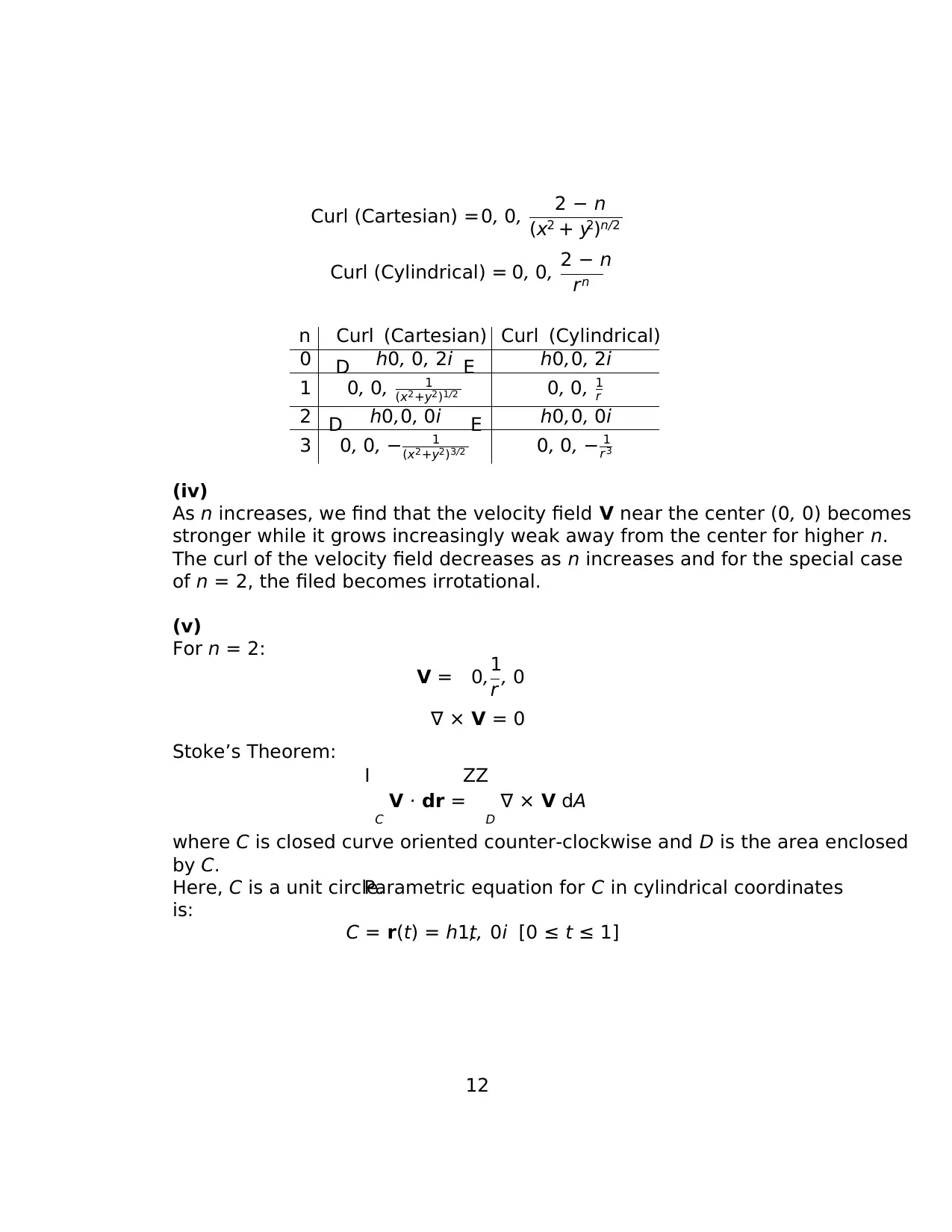
Curl (Cartesian) =0, 0, 2 − n
(x2 + y2)n/2
Curl (Cylindrical) = 0, 0, 2 − n
rn
n Curl (Cartesian) Curl (Cylindrical)
0 h0, 0, 2i h0,0, 2i
1
D
0, 0, 1
(x2+y2)1/2
E
0, 0, 1
r
2 h0,0, 0i h0,0, 0i
3
D
0, 0, − 1
(x2+y2)3/2
E
0, 0, − 1
r 3
(iv)
As n increases, we find that the velocity field V near the center (0, 0) becomes
stronger while it grows increasingly weak away from the center for higher n.
The curl of the velocity field decreases as n increases and for the special case
of n = 2, the filed becomes irrotational.
(v)
For n = 2:
V = 0,1
r , 0
∇ × V = 0
Stoke’s Theorem:
I
C
V · dr =
ZZ
D
∇ × V dA
where C is closed curve oriented counter-clockwise and D is the area enclosed
by C.
Here, C is a unit circle.Parametric equation for C in cylindrical coordinates
is:
C = r(t) = h1,t, 0i [0 ≤ t ≤ 1]
12
(x2 + y2)n/2
Curl (Cylindrical) = 0, 0, 2 − n
rn
n Curl (Cartesian) Curl (Cylindrical)
0 h0, 0, 2i h0,0, 2i
1
D
0, 0, 1
(x2+y2)1/2
E
0, 0, 1
r
2 h0,0, 0i h0,0, 0i
3
D
0, 0, − 1
(x2+y2)3/2
E
0, 0, − 1
r 3
(iv)
As n increases, we find that the velocity field V near the center (0, 0) becomes
stronger while it grows increasingly weak away from the center for higher n.
The curl of the velocity field decreases as n increases and for the special case
of n = 2, the filed becomes irrotational.
(v)
For n = 2:
V = 0,1
r , 0
∇ × V = 0
Stoke’s Theorem:
I
C
V · dr =
ZZ
D
∇ × V dA
where C is closed curve oriented counter-clockwise and D is the area enclosed
by C.
Here, C is a unit circle.Parametric equation for C in cylindrical coordinates
is:
C = r(t) = h1,t, 0i [0 ≤ t ≤ 1]
12
⊘ This is a preview!⊘
Do you want full access?
Subscribe today to unlock all pages.

Trusted by 1+ million students worldwide
1 out of 13
Related Documents
Your All-in-One AI-Powered Toolkit for Academic Success.
+13062052269
info@desklib.com
Available 24*7 on WhatsApp / Email
![[object Object]](/_next/static/media/star-bottom.7253800d.svg)
Unlock your academic potential
Copyright © 2020–2025 A2Z Services. All Rights Reserved. Developed and managed by ZUCOL.





